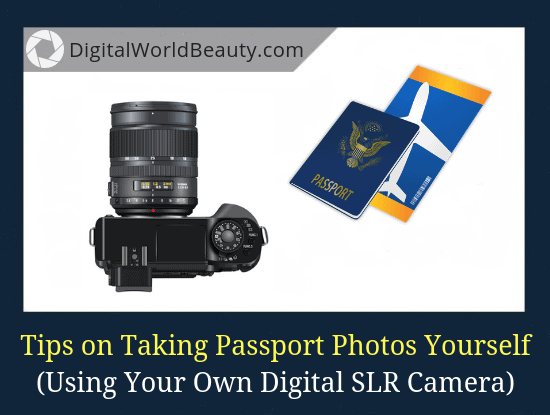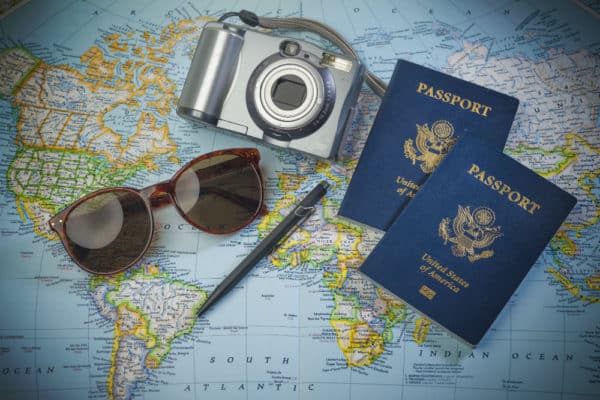Please note: As an Amazon Associate I earn from qualifying purchases. I also work with other affiliate partners and may be compensated from the links below. Details here.
How to Take a Passport Photo with Digital Camera: 5 Main Things to Focus On (Guide)

You might be surprised, but a lot of people actually take their passport photos themselves. They believe that getting their photos taken in a studio isn’t well worth the spend.
If you, too, think the same, then in this post I’ll cover how to take a passport photo with digital camera in 2021 (and beyond).
It isn’t as complicated as it sounds, especially if you have basic experience in photography.
These are the main things you’ll need:
- tripod
- digital camera
- white or off-white background
- photo paper and a printer
(Plus, there are certain guidelines to follow which I’ll discuss in a bit too.)
Anyway, if you really want to maximize the use of your digital camera for passport size photos, these tips are for you.
And if you don’t own a DSLR, not to worry, the next section to help.
Let’s get started.
Choosing a Digital Camera for Passport Photos
But first things first:
Which digital camera you need for passport photos?
If you’re new to photography, consider the following entry-level DSLRs with kit lenses (with my full reviews of each):
- Nikon D3500 – with a Guide mode that literally teaches you how to shoot.
- Nikon D5500 or D5300 – which are a bit better than D3400.
- Canon EOS Rebel T6i – my top recommend DSLR for amateurs.
Here’s a table that’ll give you a quick look of my top 3 list and the reasons to buy the product. For further details, simply click ‘review>’ in respective row.
Product | Image | Reasons to Get It | |
1. Nikon D3500 Starter DSLR to learn photography |
| ||
2. Nikon D5300 One of the best beginner DSLRs! |
| ||
3. Canon T6i Versatile & great price/quality ratio |
|
These cameras certainly will be easy on you and will get the results you need.
What about the lenses?
Ideally, you’d want to get a 50mm prime lens with a fixed focal length. Although, for cropped sensor DSLRs, the 85mm will work better for headshot portraits.
This lens will give you the best result you can get.
Product | Tips & Reasons to Buy Today | |
35mm lens Best walkaround, versatile prime |
| |
50mm lens Best prime for a full frame camera |
| |
85mm lens Best cheap prime for portrait photos |
|
- Recommended reading: >> 35mm vs 50mm vs 85mm for portrait shots.
Now…
If you’re on a small budget and aren’t ready for prime lenses, then the 18-55mm kit lens will give a pretty decent result too. For passport photos will be enough.
(Kit lenses come with all the cameras I mentioned above, basically it’s a package deal.)
Important Guidelines to Follow
To be clear:
I cannot generalize the set of guidelines when it comes to passport photos because it varies from one country to another.
However, almost all countries tend to adhere to some set rules, such as the background, your ensemble, exposure, accepted expressions, and the likes.
Here are some of those guidelines:
- Your face must be in full view, directly facing the camera.
- It’s required that you have neutral expression.
- You can wear what you wear on an everyday basis.
- You need to submit a recent photo of yours (within the past 6 months).
- The background should be plain white or off-white.
- Your photo can be printed on a glossy or matte photo paper.
- It must be a colored photo.
- No glasses or hats unless for medical or religious purposes (provide signed statements).
- You should not be wearing headphones or any other devices that are wireless.
- The size of the photo must be two by two inches or 51 mm by 51 mm. Accordingly, your head should be 1 to 1 3/8 inches from the bottom of your chin up to the top of your head.
Here’s a source of digital image requirements (in the U.S.) if you decide to take a photo yourself.
Like I mentioned earlier, this is isn’t a complicated process.
Basically, you need a decent DSLR, a tripod and a well-lit room to take the passport photo yourself. There are no fusses regarding editing, complicated backgrounds, and even filters.
This being said, let’s talk about tips and tricks to take a passport photo on your own.
How to Take a Passport Photo With Digital Camera
NOTE: No eyeglasses and no smile is allowed in 2021.
Now, The Text-Based Instructions
Learning photography has never been easier…
Digital Camera Mastery is my #1 recommendation for beginners to help you become a better photographer. Read my full review now.
First of all, you can just leave the settings of your camera in Auto mode.
Of course you can play with some of its settings such as the white balance, exposure, and the likes but don’t go for settings that will distort your face shape, enlarge your eyes, or smoothen your skin.
Point is…
The photo should be as what you look like in person, as much as possible.
(Also, if you have a mirrorless camera, you can switch out the lens to have more focus.)
Makes sense, right?
1. The Background
You don’t have to buy a white background. All you have to do is to find a white or off-white wall.
Make sure that this wall is also smooth, or if it is not that smooth, you can still take your picture there and post-process it at a later time.
Another thing that you can do is to stick a piece of white paper or cardboard on the wall.
Alternatively, you can also just hang a white cloth at your back.
2. The Lighting
Natural lighting is best, so you don’t have to worry about artificial lights.
In fact, you can simply take a photo in front of a window or even outside. If you really need to use artificial lights, go for fluorescent bulbs. They are great because it gives the vibe of a post-office lighting.
==> Relevant reading: Why Is Lighting Important in Photography?
Now…
Don’t place it too near your face because your photo might look overexposed. Just scatter the light around you to brighten up the shot.
3. The Tripod
You have to use a tripod and set your camera to a timer setting.
This is the case because you have to sit or stand straight in the photo. Your hands should not look like you are taking a selfie.
If you don’t have a tripod, you can just put your camera on top of a stack of boxes or books.
4. The Editing
Once you take the picture that you like, you still have to edit it using either a computer software (like Photoshop) or an application in your phone.
Click here to get Adobe Photoshop today.
You can edit the lighting, as well as the color of your shirt but do not alter the way you look.
Now…
This resource is great on teaching how to edit your photographs.
Deleting a few stray hairs is good, but doing other face modifications should not be done. Also, this is when you can crop the photo based on the passport photo regulations.
5. The Printing
You are now ready to print!
Use a photo paper and set the print settings to high quality so you can have a vivid picture.
Keep in mind that some passport photos are laminated, or there is a clear coat applied to the top. You just have to make sure that when they do those things, your picture still looks clear.
How to Make Digital Photos High Quality
Passport photos must be clear and crisp. Let’s go over some essential guidelines to follow to achieve the best possible picture quality when using a digital camera to take passport photos. There are some things that you can do to improve the digital image’s quality.
1) Passport photos need to be very clear, which means you cannot have any camera shake when taking them. This means holding the camera properly, so it does not shake in your hands. Something else you want to look for is a digital camera with either in-body image stabilization or in-lens image stabilization, as this can help reduce shake.
2) If you are working with long exposure times, aim for an electronic viewfinder. While optical viewfinders are excellent for some purposes, they don’t excel at minimizing shake during longer exposures.
3) For low light conditions, such as in a dim passport photo studio, you may want to crank up the ISO on your camera. Having better light exposure will help create better clarity and crisper colors.
4) Something else when taking photos for passports with digital cameras is never to use the flash. Flash won’t get you very far if the lighting is already decent. Moreover, that flash creates a glare that will not go over well for passport photos.
5) If you are taking a digital photo for a passport, such as an online application, pay attention to the image’s resolution. Passport photos don’t need to be HD or 4K by any means. The maximum resolution for passport photos, at least in the US, is 1,200 by 1,200 pixels. However, there is also a minimum resolution, 600 by 600 pixels. The best option is somewhere in between. On a side note, the image must be in JPEG format in terms of the correct size, and it must be no larger than 240 kB.
6) If you are using digital zoom, be sure you get the proper distance from the subject. With digital zoom, you want to ensure that the camera’s distance to the subject is correct to prevent any distortion from happening to the image. You don’t want to take a long-distance photo and then zoom in on it. If possible, using a camera with optical zoom is recommended.
While following the correct size guidelines for a digital photo for passports and the image’s size is very important, do not edit.
Thanks to Instagram and photo editing tools, it has become super easy to make large-scale edits to photos. People use filters to make themselves look better, almost like different people.
Passport scanners use biometrics to make sure that you are actually you and that your passport is legitimate. If you change the digital photo too much with edits and enhancements, your photo won’t be considered accurate, so don’t edit your passport photos. Leave them as they were taken.
Taking Passport Photos on Your Own

Basically that’s how you take a passport photo with digital cameras (for headshots).
Pretty easy, right?
And you don’t even need any fancy passport photo camera.
Simply work with what you have, and boom! You were able to save a trip to a photography studio (not to mention a few bucks).
Remember that you still have to follow the passport photo guidelines because, at the end of the day, even if your goal is to look pretty or handsome in your photo, a passport photo is still going to land in a government-issued document.
Now…
I’d like to hear from YOU:
- Any other questions on digital cameras for passport photos?
- Any tips you’d like to provide yourself?
Let me know in the comments, I’m happy to help!
Ready to crush it as a photographer this year?
Get this practical photography course to take you from zero to photography hero in a matter of weeks. Join the program now.



